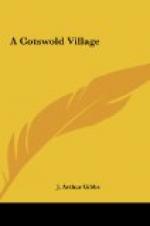In these woods of Chedworth the rose bay willow herbs grow taller and finer than is their wont elsewhere. In every direction they spring up in hundreds, painting the woodlands with a wondrously rich purple glow. Here, too, the bracken thrives, and many a fine old oak tree spreads its branches, revelling in the clay soil. On the limestone of the Cotswolds oaks are seldom seen; but wherever a vein of clay is found, there will be the oaks and the bracken. Every forest tree thrives hereabouts; and in the open spaces that occur at intervals in the forest there grow such masses of wild flowers as are nowhere else to be seen in the Cotswold district. White spiraea, or meadow-sweet, crowds into every nook and corner of open ground, raising its graceful stems in almost tropical luxuriance by the brook-side. Campanula and the blue geranium or meadow crane’s-bill, with flowers of perfect blue, grow everywhere amid the white blossoms of the spiraea. St John’s wort, with its star-shaped golden flowers, white and red campion, and a host of others, are larger and more beautiful on the rich loam than they are on the stony hills. Even the lily-of-the-valley thrives here.
In the bathroom may be seen an excellent example of the hypocaust—an ingenious contrivance, by means of which the rooms were heated with hot air, which passed along beneath the floors.
In the museum are portions of the skulls of men and of oxen, the antlers of red deer, oyster shells, knives, spear-heads, arrow-heads, bits of locks with keys, and excellent horseshoes, not to speak of such things as bronze spurs, spoons, part of a Roman weighing-machine, and a splendid pair of compasses. There are pieces of earthenware with potter’s marks on them, and red tiles bearing unmistakable marks of fingering, as well as footprints of dogs and goats; these impressions must have been made when the tiles were in a soft state. But the most interesting relics are three freestone slabs, on which are inscribed the Greek letters [Greek: chi] and [Greek: rho]. It was Mr. Lysons who first noticed this evidence of ancient faith, and he is naturally of the opinion that the sacred inscription proves that the builder was a Christian. Another stone in this collection has the word “PRASIATA” roughly chiselled on it.
There was a British king, by name Prasutagus, said to have been a Christian, and possibly it was this man who built the old house in the midst of the Chedworth woods. A mile beyond this interesting relic of Roman times is the manor house of Cassey Compton, built by Sir Richard Howe about the middle of the seventeenth century. It stands on the banks of the Coln, and in olden times was approached by a drawbridge and surrounded by a moat. The farmer by whom it is inhabited tells me that, judging by the fish-ponds situated close by, he imagines it was once a monastery. This was undoubtedly the case, for we find in Fozbrooke that the Archbishop of York had license to “embattle his house” here in the reign of Edward I.




